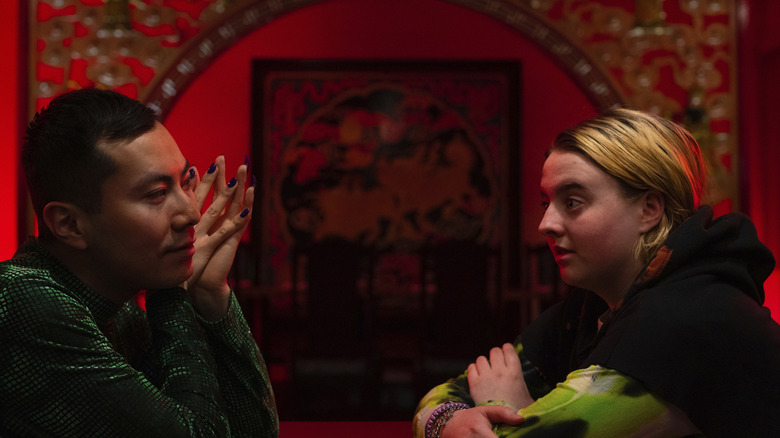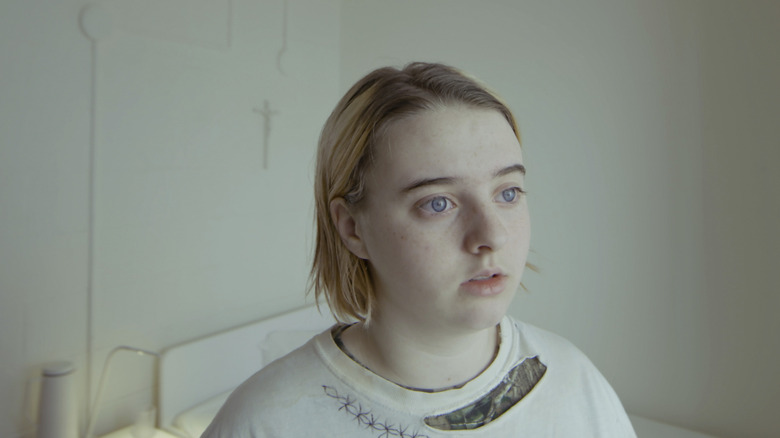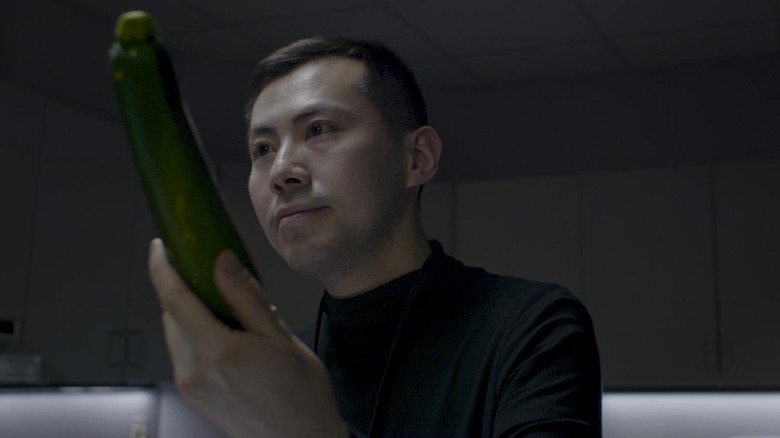Queens Of The Qing Dynasty Review: A Queer Friendship Set To Electronic Music And Lyrical Textures [NYFF]
There are chemicals mixed into the magical focal bond in "Queens of the Qing Dynasty." It's perhaps incomprehensible in normal terms but easier to feel in the visual textures of a film about two misfits.
The sophomore feature of Canadian director Ashley McKenzie (the 2016 "Werewolf"), "Queens of the Qing Dynasty" expresses a fixation on particles: the freckles, the frost, and the fingernail dust. Twenty minutes into the film, we're privy to a medical appointment where a scope is lowered into an esophagus and slithers into slimy innards. An unorthodox rhythm is spun out of the mechanical wriggle of the tube and the dilated pupils of the patient, the wide-eyed Canadian teen Star (Sarah Walker). Such textures, visual and sound, define Star's existence as a neurodivergent teen.
Star speaks in her own terse vernaculars. Her perpetual facial placidness is not to be mistaken for stoicism, vacancy, or aloofness. She holds a constant curiosity about what those around her expect of her. She is also matter-of-fact open about what landed her in the hospital: a past of incest, sexual assault, impregnation committed against her, and the ensuing suicide attempts. Sequestered under suicide watch, Star is navigating her dependency on others.
Then she acquires a friend in An (Ziyin Zheng), a genderqueer international student from Shanghai volunteering at the hospital for degree credit. An is at a much different and uncertain transitory period from Star's, having an upcoming citizenship test to worry about and they're learning to embrace their sexuality and gender identity in Canada. Theirs and Star's interactions began to formulate a certain code between them.
Speaking in code and cinematographic closenesss
Most stories with suicide attempts in the backdrop can collapse into rawness. "Queens of the Qing Dynasty" does no such thing nor flirts with tear-sopping drama. It maintains the shots with a mechanical movement but nor does that bleach out the humanity. We notice that Star is self-practiced at resisting norms and decorum for her self-preservation. When an implied relative visits her and implores her to dress neatly, she claws onto the relative's plastic bag like a stubborn kitten. In another glimpse of hospital life, Star engages in a coughing fit in the lunchroom to drive away the occupants so she and her friend can have the room to themselves and pile her mash-potatoes and beans on her jello into a sludgy tower.
An and Star are two souls who exist on an entirely different wavelength than the world around them, so Scott Moore's crisp and clinical cinematography sharpens the texture into the lyrics of their lives. The camera shots are candidly sterilized but bring us close to Star and An, often gandering at their eyes. During one conversation, the camera sharply focuses on the snow frost on her twitching eyelashes. There's no other person in the film Star has a rapport with because the camera does not shoot with such intimacy whenever she's in conversation with someone else. "We're flirting?" She casually asks An because she needs some social cues clarified. No, though she's more on point when she remarks, "We're mixing chemicals."
You can hear the gears and cogs turning and whirling in An and Star's interaction through the musical electronic churns, chugs, and grinds in Yu Su and Cecile Believe's score, mixed with Andreas Mendritzki's swish-and-scrapping sound design. The sonic landscape doesn't so much accompany the pair but inhabits the environment like moons rotating around a planet. Spliced in are original freewheeling animation by Cyril W. Chen to color Star's inner headspace.
A frank portrait of neurodiversity
Though I do question if the screenplay does cross into underexamined exotification of An's Chinese culture through a Western lens, it is at least cautious at not reducing An into a marginalized fix-it fairy for Star's problems. An holds boundaries around their own existence, which Star grasps once told ("How much is too much?" She earnestly asks when they mention she called them 67 times). In the film's third act, she makes a marriage proposal in hopes of splitting disability benefits.
That way, in her own logic, An could gain citizenship and be provided for, and perhaps (not spoken aloud) she gets to keep An longer in her life. An rejects such, not without being flattered because they know that the system would scrutinize their union and (not spoken aloud) they sense a transactional marriage wouldn't groove for them.
Then in one assured gesture, one that Star understands more than the audience can, An swaddles her in a blanket (you'll understand the callback when you watch the film). An is assuaging Star's disappointment as much as they're assuring her that she will emerge out of the cocoon in some way. And rest assured, Star will find her way to emerge.


